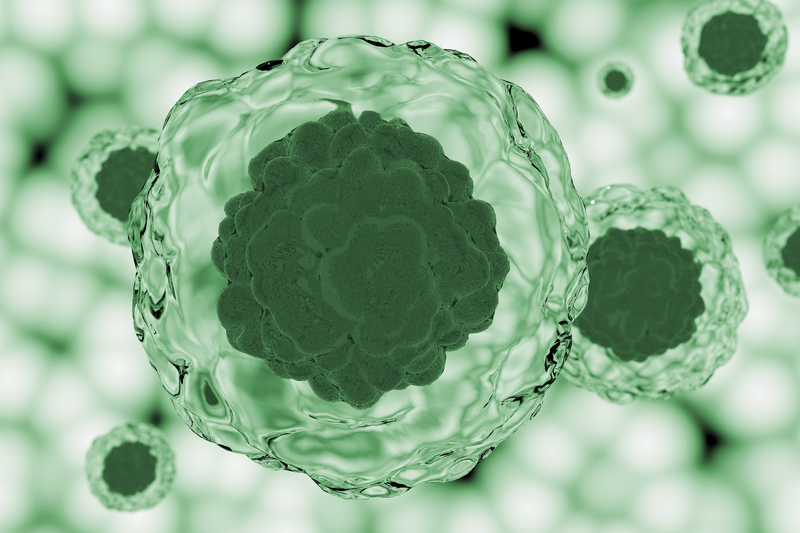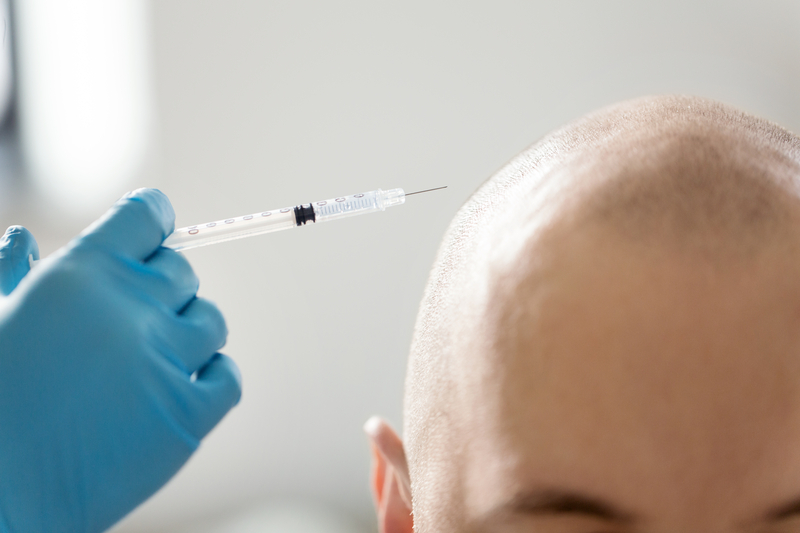Exosomes For Hair Loss: Legit, Or A Scam?
With hair loss, most people know that your available options are far and few: Prescription drugs, hair transplant surgeries, hair fibers, and on the list goes.
But in humanity’s endless quest to fix the gradual disappearance of hair once and for all, new solutions have been discovered by hair loss practitioners.
One of them happens to be the use of exosome therapy, a medical technology powered by stem cells to reportedly reverse hair loss.
It’s purported to work for multiple conditions such as pain and erectile dysfunction… can be the same be said for your scalp?
Keep reading this article and you’ll discover whether exosome therapy is the right solution for balding men and women.
What Are Exosomes, And What Do They Have To Do With Hair?
Put simply, exosomes are a unique kind of non-replicating particle that is produced in your cells.
They are a type of extracellular vesicle responsible for the transfer of molecules from one cell to another — things such as select components of a cell, fats, proteins, and more allow cells to signal with one another and hence influence parts of your bodily function such as your immune system.
At roughly 30 to 150 nanometers in diameter, they are believed to be one of the smallest types of extracellular vesicles to exist.
While the exact connection between exosome and hair loss is still being studied, it is known that the exosomes used to treat hair loss come from stem cells:
“…researchers have attempted to use cell therapy to treat hair loss by culturing and proliferating hair follicle cells or mesenchymal cells in vitro and then implanting them in the bald area.
In the anagen phase, the hair follicle bulge area is an abundant source of actively growing dermal papilla (DP) cells, which drop out during the resting phase. It has been suggested that hair follicles in bald areas are not disappearing but decreasing in size “
“The differentially expressed secretome or exosomes from DP spheroids and DP cells could be the key to regulating hair follicle cycles. Recently, DP cell–derived secretome and extracellular vesicles have demonstrated their effect in promoting hair growth, and their mechanism is under immense investigation.
Compared with mesenchymal stem cell–derived exosomes , DP cell–derived exosomes were demonstrated to be efficient transforming growth factor–β activators and proven to be important in promoting proliferation of human hair follicle DP cells and hair growth”
This consequently results in the release of numerous growth factors that are critical for hair growth:
“DP cells are capable of releasing growth factors that direct epithelial cells to proliferate, leading to hair shaft growth and acceleration of hair regeneration. Our results revealed that VEGF and IGF-1 gene expression and release were significantly increased in a dose-dependent manner by MSC-EV treatment.
Several studies have shown that VEGF can promote hair growth, enlarge follicle size, and increase hair thickness. In the skin, IGF-1 is expressed by cells of the dermis and the DP of hair follicles, and hair growth from human follicles can be achieved by stimulating IGF-1 induction in DP cells”
That’s the 101 of how exosomes are believed to work for hair growth.
And while we don’t have enough clinical research in humans to definitively prove their effectiveness and safety, a lot of anecdotal evidence is popping up from anti-aging clinics around the world:
“In this study, hair density and thickness were measured at start of treatment and 12 weeks after exosome treatment in 20 patients with androgenic alopecia (AGA). The researchers reported that exosome therapy increased mean hair density from 105.5 to 122.7 hairs/cm2 and mean hair thickness from 57.5 to 64.0 um from baseline to assessment at week 12, respectively. The researchers also stated that patients reported no serious adverse events.”
In this context, “therapy” means an injection directly into the scapular tissue much like you would with for treating hair loss.
But before you make your final decision with this experimental hair loss treatment, you may want to see some of the downsides first…
4 Reasons Why You Should Avoid Exosomes For Hair Loss
As promising as exosomes look for hair regrowth, there are a lot of details that often aren’t directly disclosed to the patient until they do some further digging.
Some of these downsides may be dealbreakers or mean nothing to you, yet we suggest you review them anyways so you are equipped with the information you need to make an informed decision.
Exosomes For Hair Loss Are VERY Expensive
Be ready to spend a significant amount of money on a single treatment of exosome therapy.
The estimates range from anywhere between $3,000 and $10,000 — certainly not chump change.
Even the lower end of that range is already more than enough to give people great concern about spending thousands of dollars on a hair loss treatment that’s still under scientific investigation.
And many factors come into play when dialing down what it will cost for you and your hair restoration goals:
- The experience of your attending physician (more experienced ones generally tend to charge more)
- The location of the clinic offering exosome therapy (a higher-end area will likely lead to a more expensive cost)
- Your individual circumstances (how much hair you want to grow back, underlying medical conditions, etc.)
For some people, their money would be better spent elsewhere.
Exosomes For Hair Loss May Have To Be Continuously Used
This is by and far one of the biggest concerns with exosome therapy: Nobody has a definitive answer as to how long the new hair growth will last following a single treatment.
Some people believe the results are permanent or claim successful maintenance of new hair 1 year post-treatment, while others speculate a new injection will be needed every 6-12 months.
There’s just simply no way to know how many injections it will take before treatment is no longer necessary.
But given the costs you just saw earlier, one treatment may be all that the average person may be able to afford.
And why tie yourself to something that you have to keep taking for life, such as Minoxidil?
Exosomes For Hair Loss Have Some Practical Side Effects
Unlike arguably harmful hair loss drugs such as Finasteride, exosomes have a far superior safety profile.
Despite a claim of zero downtime and the total process taking no more than an hour, it’s not out of the woods just yet.
Because even though the effects may be minor, these are all reported anecdotally and more data on adverse events are needed:
- No exercising (i.e. perspiration) for 24-48 hours following the treatment to avoid undesirable increases in heart rate or blood pressure
- Mild pain and swelling at the site of injection, but usually subsides within 24-48 hours
- Heigthened sensitivity in the scalp for 1-7 days after treatment
- Risk of infection/bleeding/scarring at the site of injection
- Non-steroidal anti-inflammatory drugs cannot be taken 3 days before treatment or 3 weeks after treatment to avoid compromising potential hair growth (i.e. aspirin, ibuprofen, etc.)
- It takes anywhere between 8 weeks to 6 months for visible results to appear, which varies wildly depending on the individual (gentic predisposition to hair loss, degree of hair loss, age, etc.).
On the plus side, concerns such as an “immunogenic response” can be ruled out due to how exosome therapy actually works.
Yet this is only what’s been reported so far… it’s entirely possible this is as “bad” as it gets, but it’s entirely possible to eventually see long-term side effects that were not previously accounted for.
Exosomes Are Still An Experimental Treatment For Hair Loss
At the end of the day, there is an awful lot we don’t know about the health benefits or harms of using exosome therapy for hair restoration.
Concerns such as potential tumorigenecity, exosome isolation and preparation, standardization of an injection protocol and subsequent followup, and much more still need to be addressed.
And as one physician correctly claimed, “there is no guarantee of getting any significant hair regrowth” — and even the clinicians offering this treatment can’t make the same guarantee.
Even the Food and Drug Administration (FDA) has put out two warnings regarding the use of exosome therapy for hair loss and other health conditions.
The first one was released in December 2019 amid concerns of patients experiencing unwanted negative outcomes:
“The Food and Drug Administration (FDA) is informing the public, especially patients, health care practitioners, and clinics, of multiple recent reports of serious adverse events experienced by patients in Nebraska who were treated with unapproved products marketed as containing exosomes”
“The clinics currently offering these products outside of FDA’s review process are taking advantage of patients and flouting federal statutes and FDA regulations. This ultimately puts at risk the very patients that these clinics claim to want to help, by either delaying treatment with legitimate and scientifically sound treatment options, or worse, posing harm to patients, as evidenced by these recent reports of adverse events”
The second warning was a consumer alert issued in July 2020 to warn people who were using exosome therapy to treat problems far more debilitating than hair loss:
“FDA is concerned that many patients seeking cures and remedies may be misled by information about products that are illegally marketed, have not been shown to be safe or effective, and, in some cases, may have significant safety issues that put patients at risk”
“Stem cell products are regulated by FDA, and, generally, all stem cell products require FDA approval. Currently, the only stem cell products that are FDA-approved for use in the United States consist of blood-forming stem cells (also known as hematopoietic progenitor cells) that are derived from umbilical cord blood. These products are approved for use in patients with disorders that affect the production of blood”
Science-Based Medicine has also done a good job chronicling the growth and necessary regulation of exosome products, which we recommend reading if you are truly interested in this topic.
We’ll close off on this final disclaimer from a hair restoration physician who sets realistic expectations for his patients:
“As with ANY hair regrowth therapy or procedure, results may vary. The power, performance, and duration of the measurable and visible results from exosome therapy for hair growth depend on many variables, including age, genetics, risk factors, degree of hair loss, hair quality (color, curl, diameter, density), as well as the use of adjuvant therapies like pharmaceuticals, laser therapy, nutraceuticals, etc.”
What You Should Do Instead of Exosomes For Thicker, Fuller, Healthier Hair
If exosome therapy for hair regrowth is too risky, there obviously has to be a superior alternative for hair follicle restoration.
Something which is non-invasive, painless and allows you to see immediate results in the aesthetics of your hair without spending thousands of dollars every year for the rest of your life.
Vantis Follicle Replication is the only proven solution in the hair loss market which meets all of the above criteria, which works via a harmless paramedical micropigmentation process without any side effects whatsoever.
But the benefits don’t just end there:
- Zero downtime: Live your life immediately after you’re done, no extra precautions necessary
- One-and-done: The results are evident in the short-term, the long-term, and permanently
- Looks exactly like the real thing: Even if you choose to shave your hair off, it will always appear as if you already had a full head of hair and simply wanted to try a new look (the “5 o’clock shadow” people commonly talk about)
- Never too late: Whether your hair loss just started or has been bothering you for years, we can always find a workaround to dramatically improve your appearance
If you don’t believe us, the night-and-day transformations on our website from skeptical consumers should alleviate any concerns you have.
Should you wish to go down this route and discover what Vantis Follicle Replication is all about, here are 3 easy ways we can help you today…
- Visit our hair loss clinic in Newport Beach, California and receive a Free Consultation with a Vantis hair loss expert.
- Call or text (949) 577-6531 to talk to one of our VFR expert practitioners now
- Receive a virtual consultation via Zoom, Facetime, WhatsApp, GoogleMeet or Skype to answer all of your questions and develop a personalized treatment plan to achieve your desired results. Schedule your FREE consultation here


